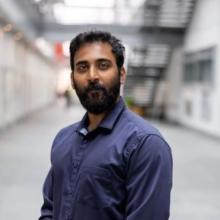
Nithin, an Aeronautical Engineering PhD student, is building AI driven smart computer systems to help researchers solve complex physics and engineering problems. His work on Large Language Model driven scientific discovery (CFDLLMBench), is the first to benchmark how powerful AI models like ChatGPT can assist and improve computer simulations of fluid flows. His proposed solutions for AI simulations will eventually positively impact industries from aerospace, automotive, climate, energy, and healthcare. With the help of advanced Large Language Model (LLM) agents, Nithin aims to accelerate the process of scientific discovery.
Early in his Bachelors of Technology in Aerospace Engineering program at Amrita University (Coimbatore, India), Nithin studied fluids and thermal domain with an emphasis on computational methods like CFD and FEM. He developed a free vortex model coupled with blade element momentum theory during his computational study of wind turbines, resulting in a publication in the International Journal of Renewable Energy Research.
Following is Bachelors, Nithin pursued a Master’s degree at the Indian Institute of Science in Bangalore where he worked on novel heat transfer techniques utilizing the highly non-linear properties of carbon dioxide in it’s super critical state. He used computational techniques to design heat exchangers that utilize CO2 in it’s supercritical state (sCO2) as a heat transfer fluid for repurposing lost heat from power plants into useful work. These systems are very efficient and climate friendly. During this time, Nithin also offered classes to prepare other students for competitive exams.
Post Master’s degree, Nithin spent a number of years in industry. At Exxon Mobil he worked as a computational fluid scientist on physics-based modeling challenges like predicting seismic wave behavior and predicting particle settling in a non-Newtonian fluid. This fundamental research project showed his capabilities as a quick learner. It was also during his tenure at ExxonMobil that he was involved in developing a Proxy Model based optimization-based algorithm that leverages data-based techniques to aid design optimization. He developed an inversion framework that utilizes physical simulation data to train an Artificial Neural Network (ANN), on top of which the inversion algorithm is applied. This framework is used to calibrate physical models using experimental data. This effort provided Nithin with an insight into the power of combining data with physical simulations.
Later, he was a data scientist at UnitedHealth Group, where he applied AI to improve healthcare operations and customer experience. He developed a deep learning based model to predict call response patterns of customers. He also worked on natural language processing models to develop targeted solutions for the business.
A desire to explore fundamental open-ended research questions brought him back to academia and Rensselaer’s Ph.D. program. He chose RPI primarily to work with Dr. Shaowu Pan, one of the pioneers in scientific machine learning. The group’s work sits at the cutting edge of physics-informed AI, and Nithin was drawn to the opportunity to explore how deep learning can be used to solve fundamental scientific problems. The department’s strong emphasis on interdisciplinary research and its integration of AI into classical engineering domains made it an ideal place for his Ph.D. journey.
Nithin has also been actively participating in AI competitions, including Stanford’s FLAME AI Challenge, where he place 3rd out of more than 100 teams. He has presented his work at international conferences such as APS DFD and ERCOTFAC and has published several papers at the intersection of AI and traditional engineering disciplines.
“What excites me most,” says Nithin, “is the possibility of dramatically accelerating scientific discovery. Tasks that once took domain experts hours or even days—such as setting up simulations, troubleshooting code, or interpreting results—can now be done in minutes with the help of LLMs. This opens the door for non-experts to engage in simulation-based science and engineering, making advanced tools more accessible across disciplines. Ultimately, this work will benefit researchers, engineers, and even policy-makers who rely on accurate simulations to make informed decisions.”
Post-graduation, Nithin intends to return to industry where he will tackle cutting-edge research problems at the intersection of AI and science, particularly in areas that will support scientific discovery, whether by implementing intelligent simulation tools, accelerating design processes, or automating complex work flows in physics-driven domains like aerospace, energy, or climate science. His objective is to participate in high-risk, high reward research while contributing to real-world innovation at scale.
When not in the lab, Nithin can be found at the gym or experimenting with new recipes in the kitchen. Once a high school swimming champion, he loves playing soccer and going on occasional hikes.
